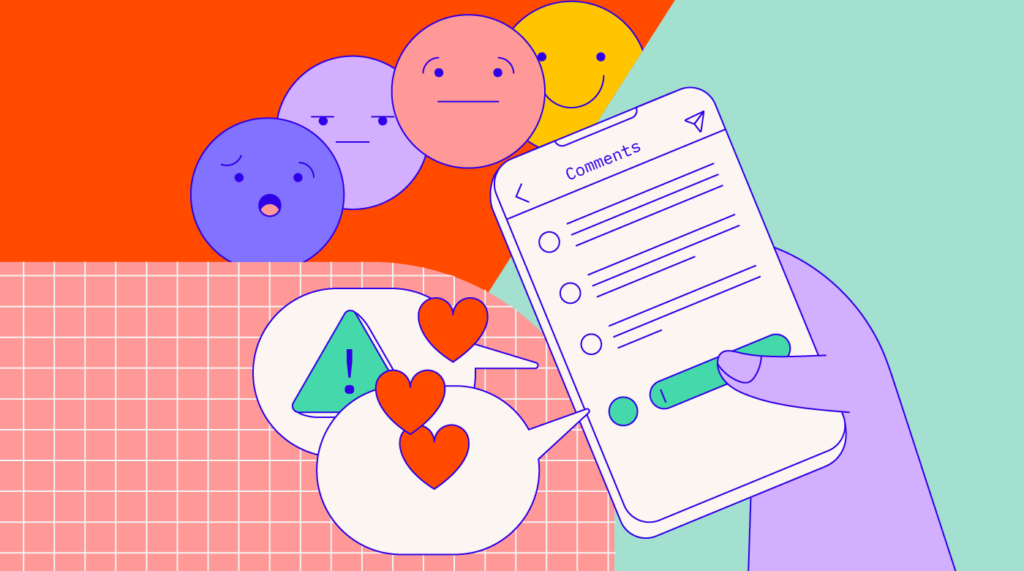Ah, social media. Depending on the day, it can feel like a vibrant town square or a toxic wasteland. But one thing’s for sure—with dozens of social media platforms and review sites, social media sentiment analysis is the only way to monitor what’s happening at scale. Fortunately, it’s worth the effort. Consumers spend 20-40% more with brands that engage with customers on social media.
At its most basic level, social media sentiment analysis works by flagging customer feedback as positive, negative, or neutral. The latest Natural Language Processing (NLP) technology lets sentiment analysis tools go a step further and accurately understand emotional tones.
Why focus on sentiment analysis? It gives you real-time customer feedback on everything from your latest messaging to how customers feel about your competitors. Sentiment analysis might even help you avoid a PR crisis before it begins.
Without a social listening and sentiment analysis strategy, you’re missing an opportunity to uncover lucrative trends, create brand loyalty, and protect your reputation.
What Is Social Media Sentiment Analysis?
People are talking about your brand everywhere online—from Facebook posts to Reddit threads to Google reviews.
Social media sentiment analysis is a way of categorizing this chatter into “positive,” “negative,” or “neutral,” and consolidating it into a quantifiable metric. Doing this lets you see how people feel about your brand over time. Sentiment analysis models can also understand the emotions your brand is evoking.
Before we explore this further, let’s look at a basic form of sentiment analysis using a tool called Social Buzz.
Here’s what its analysis shows for Starbucks:
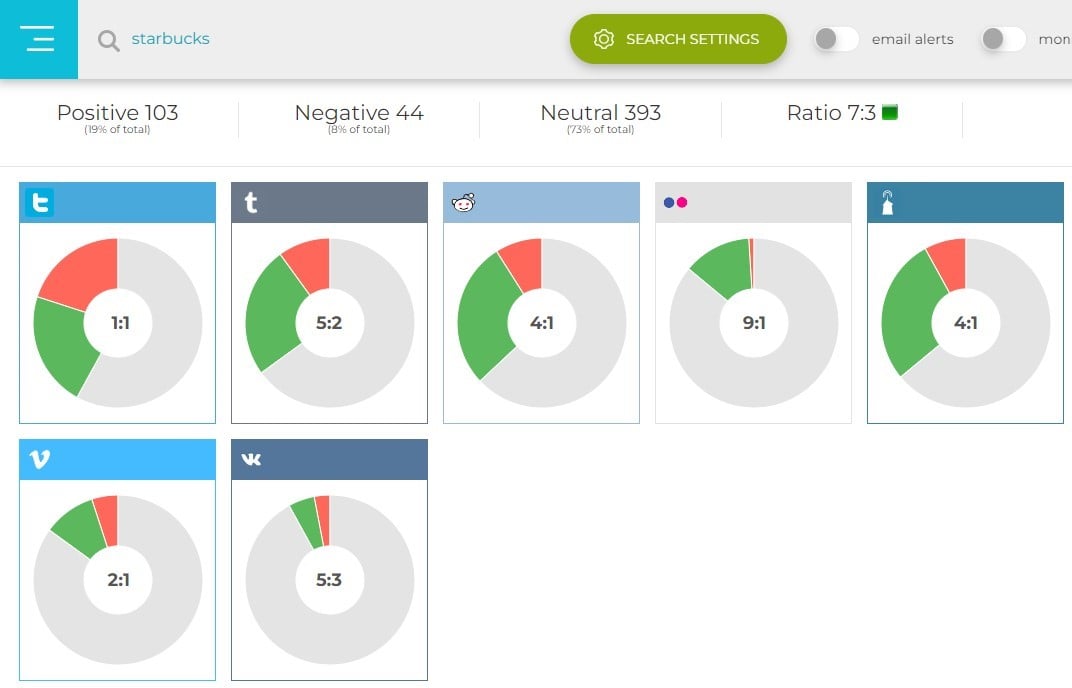
With 103 positive social mentions and 44 negative mentions, Starbucks has a 7:3 ratio of positive to negative feedback. Digging deeper, you can see that their major issue among mainstream social networks is with Twitter.
Uber does quite a bit worse than Starbucks:
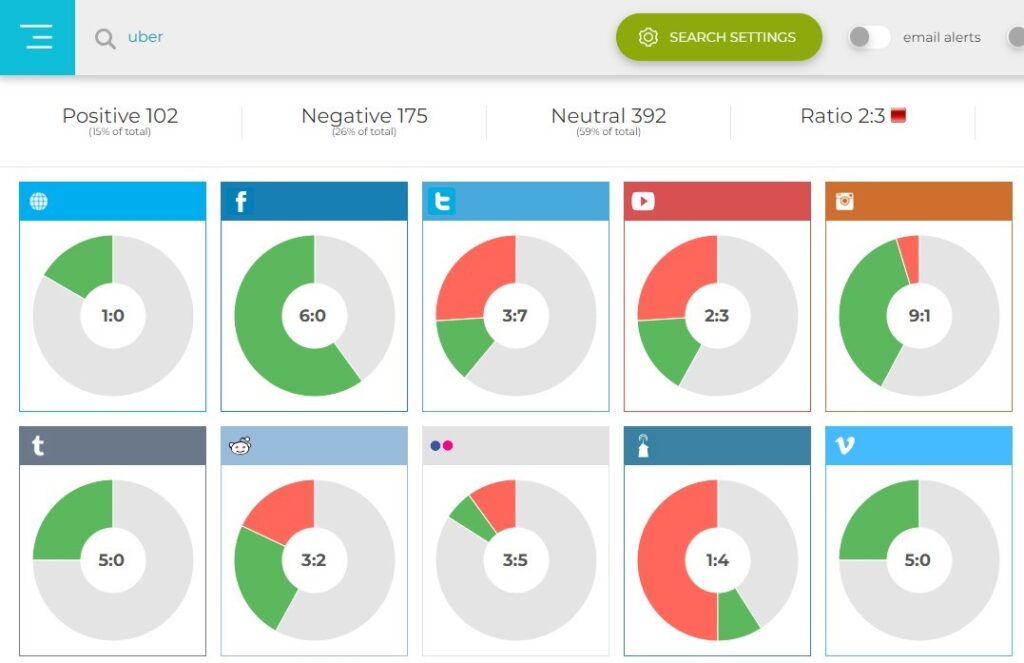
With 102 positive mentions and 175 negative mentions, Uber has a 2:3 ratio of positive to negative feedback. Twitter and YouTube are Uber’s primary challenges among mainstream social media platforms.
This data is basic, since we don’t have API access to each brand’s channels. Even so, it hints at a couple of things:
- Starbucks is generally more favorably viewed than Uber.
- If Uber wants to improve online sentiment, its social media team should probably start with campaigns aimed at Twitter and YouTube.
Analyzing Sentiment With NLP Technology
As you explore more robust sentiment analysis tools, you’ll find that their capabilities go far beyond the surface-level data I’ve presented above.
Rudimentary sentiment analysis tools look for “good” keywords and “bad” keywords. But this can easily misrepresent the data—just look at the tweet below, which has a positive sentiment but also includes a “negative” keyword.

Modern sentiment analysis tools use machine learning and Natural Language Processing (NLP) technology to understand the intent and emotions behind what customers are saying.
Here’s an example from CloudFactory, which uses AI models to understand the mixed messages and contradictions that often appear in customer feedback:
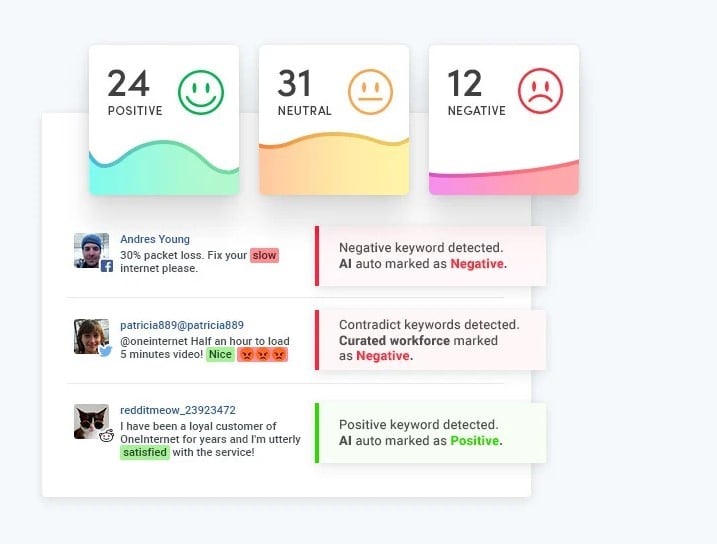
Some social media sentiment analysis tools can go a step further and assign more specific emotional markers to feedback, like:
- Sad
- Disgusted
- Depressed
- Calm
- Excited
- Elated
Sentiment Analysis vs Social Listening vs Social Monitoring
So, what’s the difference between sentiment analysis, social listening, and social monitoring?
Let’s break it down:
Social monitoring
Also referred to as brand monitoring, social monitoring tools track what people are saying about your company, brand, and products on social media.
When someone complains about your customer service on Twitter, social monitoring brings it to your team’s attention so they can deal with it fast.
Social listening
Social listening is more proactive than monitoring—it’s about using online conversations as a tool to maintain your competitive edge. Instead of focusing exclusively on brand mentions, social listening plugs you into the broader conversation in your industry.
By listening to what your competitors are doing and what customers are talking about, you can uncover market insights and stay ahead of the curve.
Sentiment analysis
When you add the ability to analyze customer sentiment to social media monitoring tools—and consolidate data from multiple channels into a single sentiment score—that’s sentiment analysis.
Sentiment analysis tools are about quantifying how customers feel about your brand and products, and tracking it over time.
The Benefits of Creating a Sentiment Analysis Plan
Sentiment analysis can help you:
- Avert a PR crisis
- Guide product development
- Test the impact of messaging
- Improve your customer experience
- Understand how customers feel about you
Think of sentiment analysis as a rich source of data to complement the other ways you’re listening to customers, like CSAT surveys and 1:1 interviews. Without sentiment analysis, you’ll rely on a much smaller sample size—and you’ll only understand your brand’s reputation among customers, not the broader public.
Here are some key reasons to monitor social media sentiment:
Get better marketing results
As you refine your social media marketing strategy based on sentiment analysis data, your messaging should resonate better with customers. 71% of brands see their marketing results improve based on insights from social listening and sentiment analysis, according to Awario.
Even basic sentiment analysis can help you understand where your promoters are, where your detractors are, and how to customize your strategy for each social media channel.
Understand your audience
Your audience isn’t static—and you shouldn’t be, either.
Just look at MoonPie. You’d expect this chocolate and marshmallow snack, invented in 1917, to have a traditional social media presence that emphasizes its long history. Instead, MoonPie cultivates a quirky brand persona that appeals to its target demographic—going so far as to create a fake sun-versus-moon “feud” with fellow consumer brand Sunny Delight.

By using sentiment analysis, you can experiment with different approaches to marketing and get fast, objective feedback on how your customers feel about what you’re doing.
Get market insights
There’s a 24/7 conversation happening on social media, complete with:
- Fast-moving trends
- Innovative competitors
- Rising and falling brand reputations
- Technology updates that make products obsolete
Without understanding these shifts, you risk becoming irrelevant. Sentiment analysis and social listening allow you to stay closely in tune with how people feel about you, your competitors, and the market—allowing you to adapt accordingly.
Improve your products
I hate to say “the customer is always right” here, but it’s truer than ever.
When one customer gives you suggestions to improve your product or complains about a customer service issue, it’s worth looking into. When a chorus of voices on social media is demanding change, your brand is likely facing a reputational crisis.
Listen closely to what people are asking for. And when possible, funnel the energy you’re seeing on social media into a collaborative product roadmap so customers can see their suggestions are being methodically incorporated.
Protect your reputation
If you only use sentiment analysis for one thing, use it for reputation management. When brands are oblivious to falling social media sentiment, it looks like they’re out of touch—or even worse, it looks like they just don’t care. Don’t do that.
Instead, watch your reputation closely. When it stumbles, dive further into audience sentiment data, as well as anecdotal feedback, to make sure that when you jump into the conversation, you do so in a careful, meaningful way.
Uncover opportunities
Imagine the following scenario:
You notice rising brand sentiment towards one of your competitors. You find out that they’ve released a popular new product and they’re getting rave reviews on their customer service. Meanwhile, your brand’s social sentiment is flat.
To evolve your brand and stay relevant, you need to keep a close eye on what’s driving excitement among customers. Social sentiment allows you to keep your finger on the pulse of the market, understand who the rising and falling players are—and emulate the winners.
Improve brand loyalty
As you get in tune with your customers and observe the kind of social media messaging they respond to, you’ll start to develop a brand persona that resonates with them, generates loyalty, and activates brand advocates.
It all starts by carefully gauging how your customers are feeling via sentiment analysis.
How Social Media Sentiment Analysis Works
New to social media sentiment analysis? Here’s a step-by-step guide to get you started:
1. Identify social channels
Sentiment analysis starts by understanding where your customers are. The answer will be different for every brand—beauty brands might need to watch TikTok closely, while B2B SaaS brands should keep an eye on Twitter and software review sites.
You’ll want to pull in as much data as possible, so make sure to incorporate any relevant data sources you can find.
2. Set up your sentiment analysis tool
Sentiment analysis tools work best when they’re integrated directly with your social accounts. (If you haven’t picked a tool yet, see our overview of the best sentiment analysis tools here).
Once you’ve settled on your tool, you’ll need to connect your social media accounts and decide on your parameters for tracking. For example, are you tracking only your company, brand, and product names—or also competitors’ names and related industry terms? Following more terms gives you more data to sort through, but it also gives you a more complete picture.
Depending on your target audience and your industry, you might need to spend some time selecting positive and negative sentiment terms so your tool filters more accurately.
3. Train the model
Although NLP-based tools are smart, they don’t always understand slang, contradictory sentences, vague emojis, or humor. And don’t even get me started on sarcasm—there’s a whole field of NLP research devoted to the challenge of sarcasm detection.
So as your sentiment analysis tool starts to observe and label customer feedback, don’t be surprised if you see some mistakes. Fortunately, the latest tools use artificial intelligence models that can learn your preferences over time.
Make time to train the model by logging in to do periodic spot checks. As you find mistakes, recategorize them, so your results get better over time.
4. Monitor the results—and take action
Check your social sentiment analysis at regular intervals—particularly after your brand has made noticeable shifts in strategy, launched a new marketing campaign, or evolved its social media persona.
Use positive movements as validation that you’re on the right track—and take action quickly if sentiment takes a dive.
Positive/negative sentiment analysis works well as a high-level barometer, but remember that when it comes time to take action, you’ll want to get more granular. To do that, you’ll need to look at what individual customers are saying.
Most sentiment tools can generate topic clouds, which show the most prominent words and hashtags currently associated with your brand. By looking for fast-rising topics of conversation, you can find the root of positive and negative sentiments.
Here’s a topic cloud for Nike, for example:
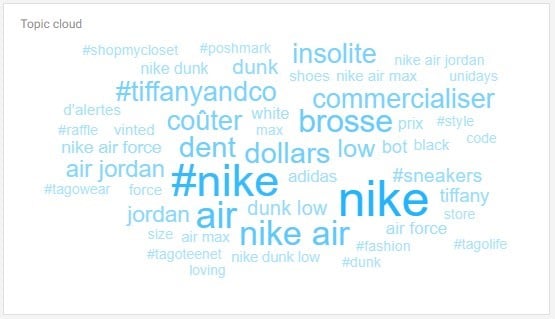
The largest terms in the topic cloud are the ones mentioned the most on social media. By clicking them, you can see individual posts and better understand what’s driving sentiment.
For example, the #tiffanyandco hashtag in this example references a product collaboration with Nike in which the two brands are launching a $250 toothbrush. Although the tool is flagging these posts as negative, it’s clear they’re actually neutral. (Crisis averted!)
The more you monitor social conversations, the better you’ll be able to spot when genuine problems and opportunities arise.
How Sentiment Analysis Can Improve CX
There are plenty of metrics that attempt to measure the customer experience (CX). But in the end, CX metrics measure a qualitative experience. CX is intimately tied to your customer base’s perception of your brand image.
That’s why sentiment analysis—along with more personalized approaches, like customer interviews—is crucial to improving CX. Unless you listen to customers to understand their likes and dislikes, you’ll never have the information needed to improve their experience.
Let’s look at a few benefits sentiment analysis and social listening have on CX:
Get Real-Time Customer Reactions
When your company changes pricing, launches a new product or undergoes a rebranding, you’re entering sensitive territory. You don’t yet know how your audience feels. This is one of the most crucial times for social media sentiment analysis.
Establish a sentiment baseline before you make a change, and watch how positive and negative sentiment evolves after the change.
You may see a short spike in negative sentiment as customers process their initial reaction to a price increase or a new logo—but if the increase in negative sentiment is sustained, you’ll want to take action and dig into individual customer comments to better understand their perspective.
For example, based on tweets like one below, Strava might conclude that they need to reassure customers that they’re adding more features in order to justify their price change.
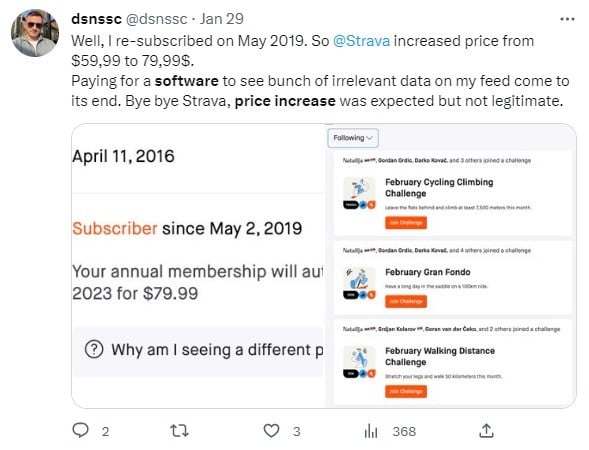
Learn What Makes Customers Happy
By monitoring customer sentiment, you’ll be able to closely track the health of your brand—and your customer experience—over time.
To proactively improve your CX, dig into the details:
- What do customers most appreciate?
- What kind of CX wins tend to get the most social media attention?
- What impact does it have when customer service reps go above and beyond?
By paying attention when customers share positive feedback on social media, you’ll be able to do more of what makes them happy—and get a better understanding of what makes you “sticky” with customers.
Elvie, a consumer products brand, has invested in personable, above-and-beyond service—and it pays off with the brand’s reputation on social media, as the example below shows.
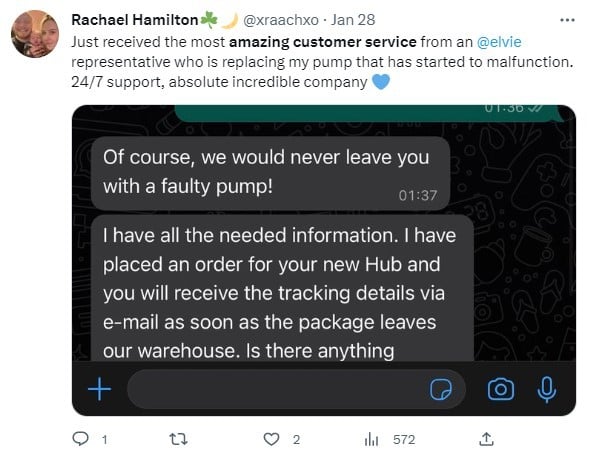
Improve Your Customer Service
Social media is a pressure release valve for frustrated customers who haven’t been able to reach you through other channels.
When customers air their grievances in a public forum, you face immediate reputational risks—but you also have an opportunity. You’ll have a serious advantage if you deal with complaints better and faster than competitors.
To do so, make sure your sentiment analysis tools are finely tuned to flag “danger keywords” that indicate that particularly damaging conversations are happening involving your brand. Whatever you do, don’t ignore these conversations. Instead, get involved and make frustrated customers feel heard.
As you monitor negative feedback, make sure to do two things:
- Solve individual customers’ complaints quickly.
- Build a list of the most common complaints and improve those issues.
You’ll see short-term CX benefits by quickly addressing customer complaints on social media, but that’s like playing whack-a-mole—it’s not a long-term strategy. Instead, find the root causes of your customers’ poor experience and fix them.
In the below example, Ryanair does a good job of being responsive to customer needs—but we have no visibility over whether they’re doing anything to prevent problems like this in the future.
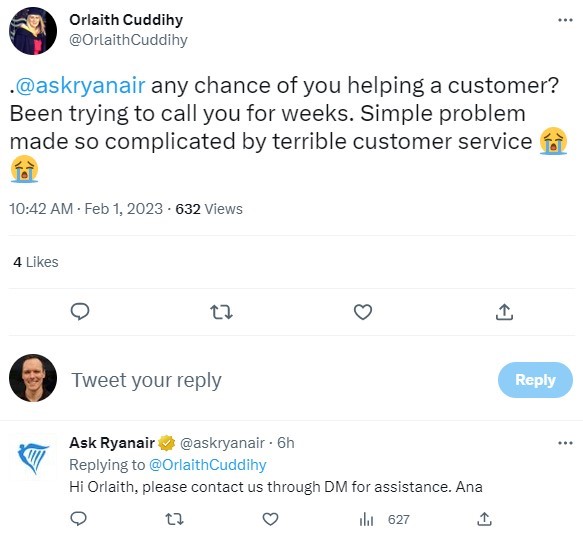
Improve Your Product
If you monitor social media conversations closely, you’ll find that customers are already telling you what product improvements they need.
A key sign that you need to improve your product is when you see customers resorting to DIY fixes on social media, like third-party patches or homemade workarounds. Those are signs that there’s a need that your product isn’t filling.
You should also be using social media to make sure customers actually want what you’re interested in building. Check rising and falling sentiment on features you’re planning to add and products you’re planning to develop. When all else fails, ask customers directly.
In the example below, Google does a good job of steering their customer toward submitting an official feature request so it can be added to the product development process.
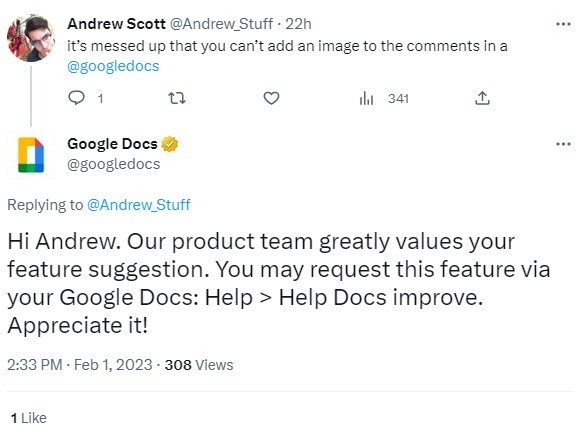
Tracking Sentiment Makes Your Brand Better
If you’ve ever checked Amazon reviews before buying a product or Rotten Tomatoes reviews before watching a movie, you’ve probably noticed something:
Individual customers are fickle.
But in the aggregate, they’re usually right.
I suggest thinking about sentiment analysis in the same way. Reviewing individual customer comments can be exhausting. For larger brands with big followings, it might not even be possible.
Social media sentiment analysis consolidates hundreds or thousands of social signals into simple metrics that help you understand the health of your brand, and help you know when you’re on the right track—and when you need to pivot.
Interested in more ways to advance your brand’s customer experience? Don’t forget to subscribe to our newsletter.
Need expert help selecting the right Customer Experience Software?
If you’re struggling to choose the right software, let us help you. Just share your needs in the form below and you’ll get free access to our dedicated software advisors who match and connect you with the best vendors for your needs.

